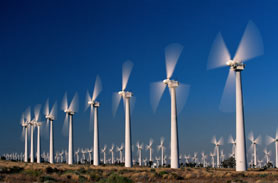
Data:
|
The Science Behind
Wind Technology |
| Wind is a form of solar energy that results from the uneven heating of the atmosphere, surface irregularity, and the rotation of the earth. When wind hits the blades of a turbine, spinning results. This spinning converts the solar energy that is stored in wind into kinetic energy, which turns an axle, which powers a pump, runs a mill, or performs some other type of function. The amount of power that is converted in this way depends on the length of the blades and wind speed. Thus, both design and geographic patterns must be considered when turbines are constructed. |  |
Updated design and experience in both operation and positioning have greatly improved the science of wind power production. Technological innovations such as improved blades, variable-speed generation, simplified mechanisms, and modern controls have improved the scope and possibility of this renewable resource. Yet wind power is still only a minor percentage of the country’s energy budget, despite economic and technological prosperity. |